Flour and water. That’s all you need to make your own yeast in the form of a homemade sourdough starter. With just a little bit of patience and this simple recipe, you’ll have a starter that will decrease your dependence on the grocery store and help you make the most amazing sourdough breads, pancakes, crackers, brownies, and more.
Sourdough captured my imagination way back at the beginning of my homestead journey.
I actually found a little post-it note in one of my old recipe books that said the date of my first sourdough starter: October 11, 2010, which was right at the beginning of my homesteading adventures here on this blog.
I’ve been doing sourdough off and on since then and have learned plenty along the way. I’ve written about sourdough in my cookbook; I showed you how to make sourdough bread in my heritage cooking crash course; I’ve even talked about sourdough a bunch of times on my Old Fashioned on Purpose podcast.
I’ve had some massive sourdough failures over the years. I’ve made the classic brick loaf that you can use as a paperweight or a doorstop. I’ve had loaves that taste way too sour or have an odd texture that no one wants to eat.
I’ve killed plenty of sourdough starters. I’ve cooked a sourdough starter by accident. I’ve let the sourdough starter die on the counter. I’ve neglected it in the fridge.
Through trial and error over 10 years of sourdough making, I’ve failed many times at sourdough, but I’ve also learned plenty of handy tips and methods to make successful sourdough recipes.
Today I’m going to show you how to make your own sourdough starter with nothing more than flour and water.
You don’t need a purchased starter and you don’t need to add extra ingredients like yeast, fruit, or sugar. This is as easy at it gets, my friend.
If you’re just getting into sourdough, I’ve got loads of awesome tutorials, podcast episodes, and videos on sourdough.
Here are more sourdough tips:
- Troubleshooting Sourdough (Answering all sourdough questions)
- Easy Sourdough Bread Recipe
- My favorite ways to use sourdough discard
- Tips for Reviving a Sourdough Starter
- Easy Sourdough Gingerbread Cake Recipe
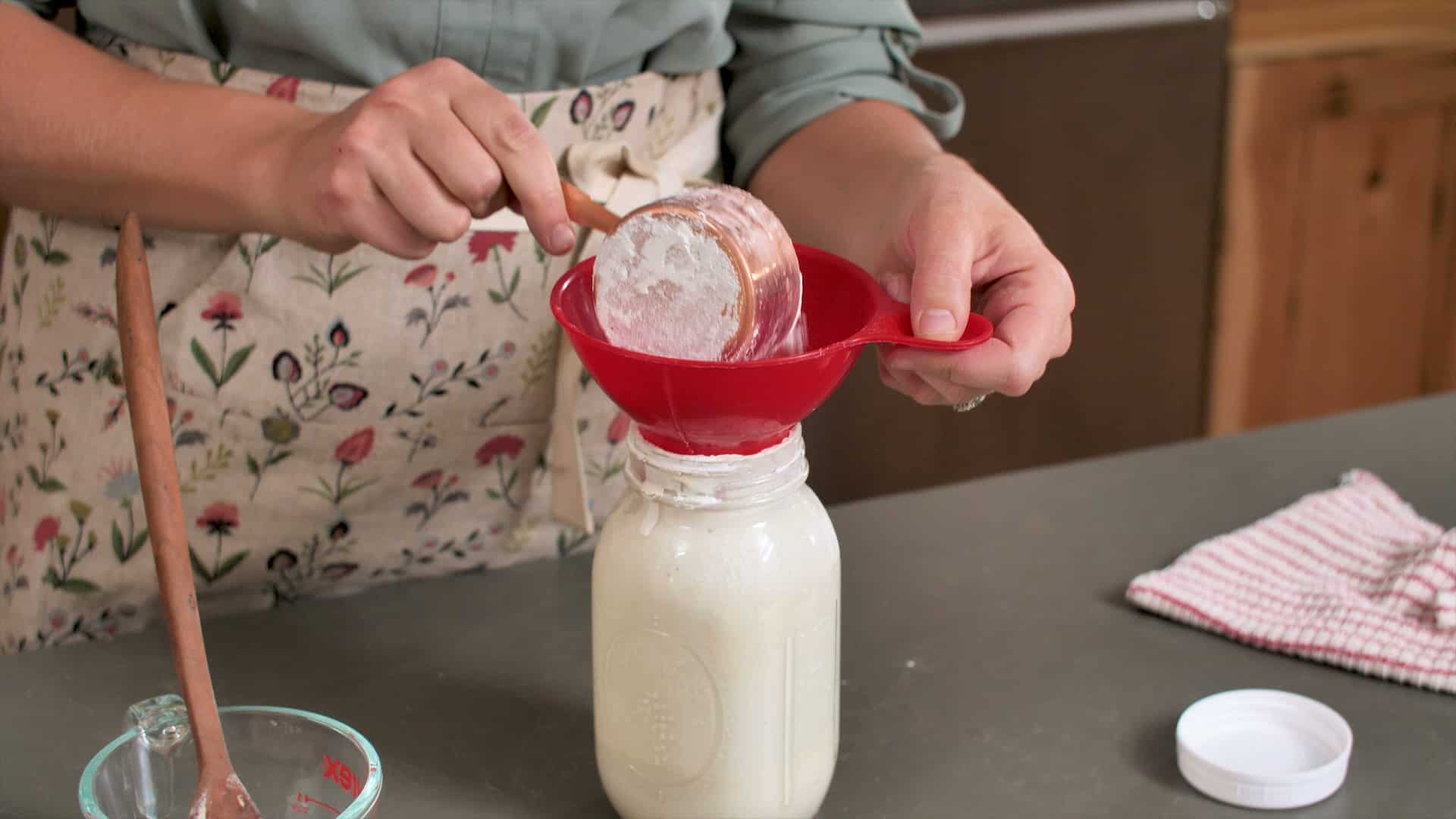
What is a Sourdough Starter?
Sourdough is simply naturally leavened bread that is made with wild yeast captured from the air. This method has been around since the beginning of time.
Using a sourdough starter does not mean your bread has to end up being super sour. Much of the sourdough bread you find at the store isn’t true sourdough. It’s often made with regular yeast and has other flavors added to make it sour.
So even if you dislike the taste of grocery store sourdough bread, there’s still a good chance you’ll enjoy homemade sourdough bread.
A real sourdough starter does not require commercially-bought yeast to get started. A true sourdough starter is simply made by combining flour and water and letting it sit for several days to either “capture” wild yeast in the air or to get the wild yeast already in the flour to become activated.
(There’s a LOT of passionate debate as to whether the wild yeast is present in the air or in the flour. I suspect it’s probably both…)
After a few days, your newly-formed sourdough starter will start bubbling, which tells you that the wild yeast is starting to become active and multiply. In order to keep that wild yeast happy, you have to feed the sourdough start with fresh flour and water over the next few days.
After about a week, your sourdough starter will be super bubbly and ready to be used.
What is Wild Yeast?
Wild yeast is all around us. It’s in the air, on your hands, in your food, in your bags of flour…yeah, it’s everywhere. Since the very first humans who discovered you could make bread from water and ground grains, wild yeast has been used for leavening.
The commerical store-bought yeast we are accustomed to seeing in grocery stores only replaced wild yeast for making bread because it’s easier for companies to make and sell. It’s also easier for bakers to store and use commerical yeast.
So, if store-bought yeast is indeed a little easier, why make your own sourdough starter with wild yeast?
Not only do I love making my own sourdough starter because I think old-fashioned living and homesteading is awesome and worthwhile, but I think that bread made with wild yeast is all-around better…it makes a superior tasting bread with a better texture that is easier for us to digest.
Not to mention, yeast isn’t super easy to find at the grocery store right now…
Fortunately, capturing wild yeast is super easy to do. If you prepare to watch rather than read, here’s my video showing how to capture wild yeast and start your own sourdough starter.
The Health Benefits of Real Sourdough Bread
Real sourdough bread has impressive health benefits for your family. The biggest health benefit with real sourdough revolves around the fact that sourdough is a fermented food.
Like other fermented foods, sourdough bread is wonderfully nutritious. As your sourdough bread dough ferments, proteins are broken down into amino acids for you, so your digestive system’s job becomes much easier.
As a result, your body is able to snag more nutrients out of the bread, since it’s easier to digest. It makes your bread more digestible, and sometimes folks who have issues with regular bread can tolerate sourdough.
Fermentation also helps to preserve food, meaning sourdough bread often has a longer shelf life than homemade breads made with commercial yeast. That’s because the fermentation process creates all sorts of organic acids that resist fungus. Basically, it’s harder for mold to grow on sourdough.
The fermentation process also breaks down the phytates, or anti-nutrients, present in wheat. This allows your body to absorb more of the vitamins and minerals in the flour.
So the fermentation process creates all kinds of beneficial nutrients in your bread, then it also makes those nutrients extra easy for you to digest. It’s one of the reasons why I love eating fermented foods (by the way, if you love fermented foods, check out my tips on how to use a fermenting crock.)
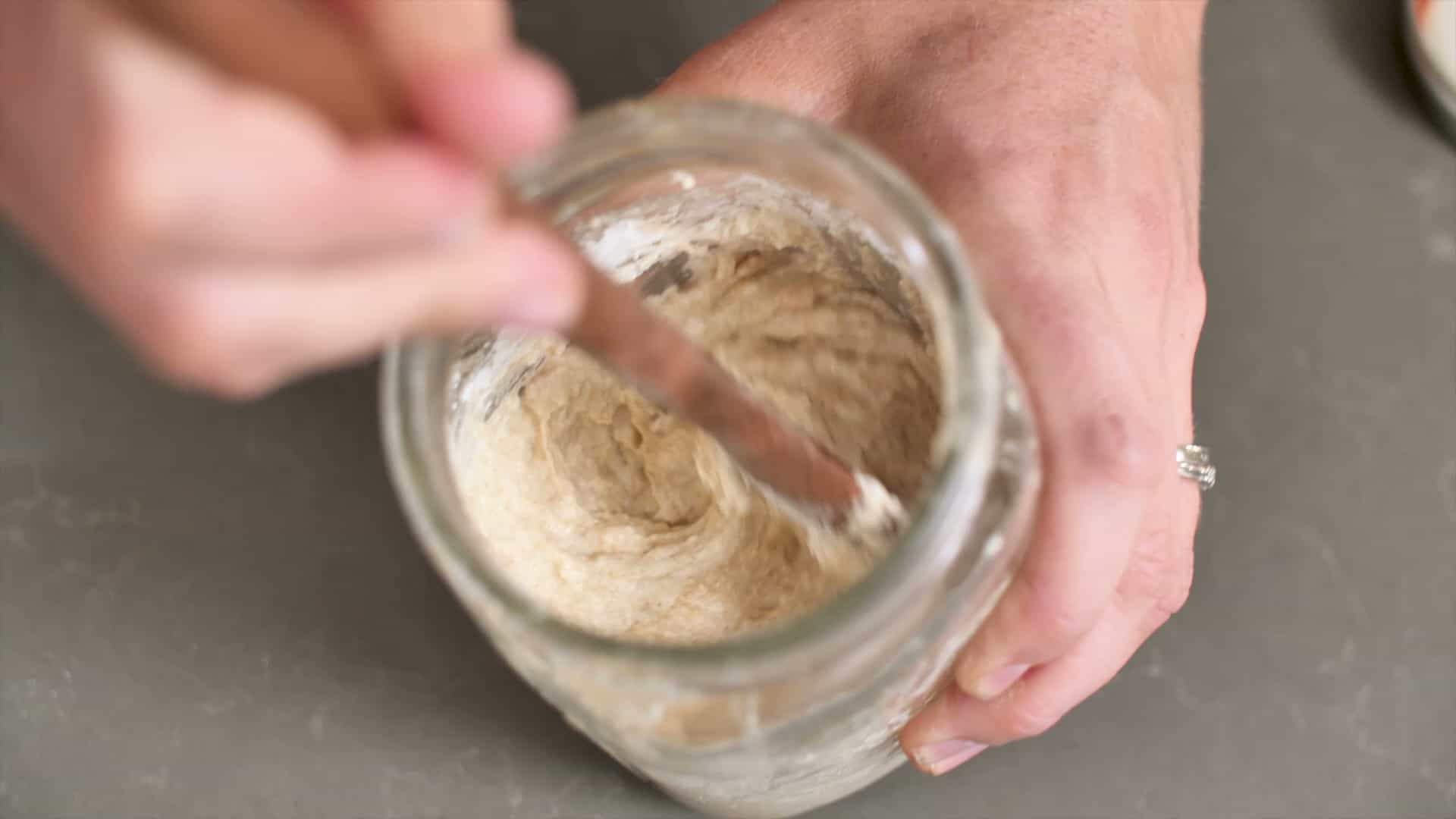
How to Make Your Own Sourdough Starter
Ingredients:
- Whole Wheat Flour* (*see notes)
- All-Purpose Flour
- Non-Chlorinated Water
Instructions:
Step 1: Mix ½ cup whole wheat flour with 1/2 cup water. Stir vigorously, loosely cover, then let sit for 24 hours.
Step 2. Add ½ cup all-purpose flour and ¼ cup water to jar, and stir vigorously. (You want the starter to have the consistency of thick pancake batter. If it is too thick, add more water.) Loosely cover, and let sit for another 24 hours. You should hopefully begin to see bubbles in your starter at this point, but if not, don’t give up yet.
Step 3. Discard half of the starter, then feed again with ½ cup all-purpose flour and ¼ cup water. Stir, loosely cover, and let sit 24 hours.
Keep repeating Step 3 until the starter doubles within 4-6 hours of you feeding it. If you still aren’t seeing any bubbles after several days of this process, it’s probably best to dump out and start over.
Once the starter is bubbly, active, and doubling consistently after each daily feeding, it’s ready to use in your recipes! (This usually happens between days 7-10.)
Sourdough Starter Notes:
- Using whole wheat at the beginning gives your sourdough starter a jump start (it contains more microorganisms and nutrients, which will make your new starter especially happy).
- Keep your sourdough starter at least 4 feet away from other cultures (like kombucha or sauerkraut) to avoid cross-contamination.
- Don’t use chlorinated water to feed your starter. If you have chlorinated city water, you can work around this problem by allowing a jar of water to sit out overnight (uncovered) for 12-24 hours. This will allow the chlorine to evaporate.
- The key to successful sourdough bread is using the starter in the proper stage of activeness — this will prevent you from ending up with sourdough bread bricks. Most people run into issues because they try to use barely active starter to make full-rise breads.
- Wide Mouth Quart jars are a great option for storing your sourdough starter, although I occasionally store my starter in a half gallon jar when I have more starter on hand.
How to Care for a Sourdough Starter
Storage For Frequent Use:
If you plan to use your starter every day (or every other day), it’s probably best to keep it on the counter and feed it daily. To do this, discard half of the starter each day, then feed it a 1:1:1 ratio — 1 part starter to 1 part water to 1 part flour (in weight).
You can get super technical and weigh this out with a scale, but I prefer to keep it simple. I usually discard all but about ½ cup of the starter and then feed it with 4 ounces flour (a scant 1 cup) and 4 ounces water (½ cup).
Storage For Intermittent Use:
If you’ll only be using your sourdough once or twice a week (or less), you can keep it in the refrigerator. This will prevent you from having to feed it daily (and ultimately using a lot of flour!).
To transfer a starter to the fridge, first feed it as you normally would. Let it sit out for one hour, then pop it in the fridge (covered). It’s best to continue to feed it weekly in the fridge, if you aren’t using it much. However, I will confess, there have been times I’ve sorely neglected my starter for many weeks and even months and I was still able to revive it.
To Wake Up a Cold Sourdough Starter:
To prepare a dormant sourdough starter for baking, bring it out of the refrigerator at least 24 hours before you need to use it. Discard half of the starter, and feed it the 1:1:1 ratio explained above — 1 part starter to 1 part water to 1 part flour (in weight).
Repeat this every 12 hours or until the sourdough starter becomes active and bubbles within 4-6 hours of feeding (this likely will take 2-3 rounds). If you need a larger quantity of starter for baking, or you’re planning on doing a big baking day, you can bulk it up by skipping the discard step in each feeding.
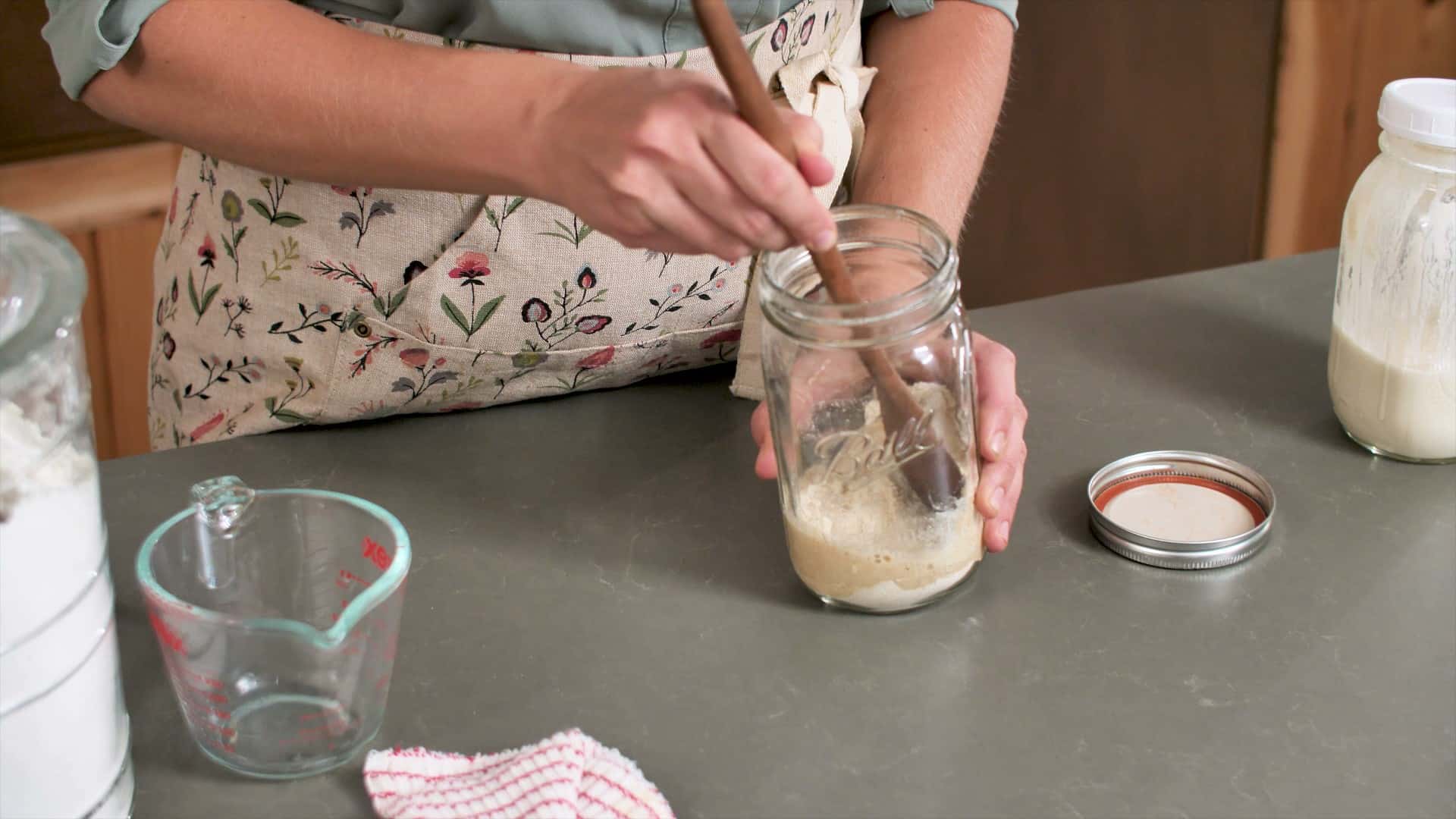
How to Make Your Own Sourdough Starter
Making sourdough starter is super easy because it only takes a few simple ingredients: flour and water. With just a little bit of patience and these tips, you are gonna end up with a happy and healthy starter that’s going to make you some of the best tasting sourdough breads, pancakes, crackers, brownies, and more.
- Category: Sourdough
- Method: Baking
- Cuisine: Bread
Ingredients
- Whole Wheat Flour* (*see notes)
- All-Purpose Flour
- Non-Chlorinated Water
Instructions
Mix ½ cup whole wheat flour with ½ cup water. Stir vigorously, loosely cover, then let sit for 24 hours
Add ½ cup all-purpose flour and ¼ cup water to a jar, and stir vigorously (you want the starter to have the consistency of thick pancake batter. If it is too thick, add more water.). Loosely cover, and let sit for another 24 hours. You should hopefully begin to see bubbles in your starter at this point, but if not, don’t give up yet.
Discard half of the starter, then feed again with ½ cup all-purpose flour and ¼ cup water. Stir, loosely cover, and let sit 24 hours.
Keep repeating Step 3 until the starter doubles within 4-6 hours of you feeding it. If you still aren’t seeing any bubbles after several days of this process, it’s probably best to dump out and start over.
Once the starter is bubbly, active, and doubling consistently after each daily feeding, it’s ready to use in your recipes!
Notes
- Using whole wheat at the beginning gives your sourdough starter a jump start (it contains more microorganisms and nutrients, which will make your new starter especially happy)
- Keep your sourdough starter at least 4 feet away from other cultures to avoid cross-contamination.
- Don’t use chlorinated water to feed your starter. If you have chlorinated city water, you can work around this problem by allowing a jar of water to sit out overnight (uncovered) for 12-24 hours. This will allow the chlorine to evaporate.
- The key to successful sourdough is using the starter in the proper stage of activeness — this will prevent you from ending up with sourdough bread bricks. Most people run into issues because they try to use barely active starter to make full-rise breads.
Sourdough Starter Troubleshooting: Your Questions Answered
Here’s some of the most common questions I get asked about sourdough. Feel free to add your own questions to the comments below.
How do I know when my sourdough starter is ready to use?
Here are the top signs that a sourdough starter is ready:
- It is doubling in size
- There are bubbles in it
- The texture is fluffy and foamy
- There is a pleasant tangy, sour aroma
- If you place a teaspoon of starter in a cup of cool water, an active starter will float on top, rather than drop to the bottom or instantly dissolve into the water
Why do I discard part of the sourdough starter?
By step three of the sourdough process, you start to discard half of the starter. This might cause alarm for some of you, and I understand, because I don’t like wasting things either. However, at this point, if you keep feeding it without discarding some of it, the starter is going to get enormous and start taking over your kitchen.
If you don’t discard some of it, you end up having to add more and more flour to make the ratio correct. Since we don’t want to waste flour, it’s actually less wasteful to discard part of the early sourdough starter. At this point in the process, the starter isn’t super sour and it’s not very fermented so you aren’t get those fermented food benefits either.
You can make some small sourdough pancakes if you want, or you could give some to a friend to get some more people passionate about making bread. Otherwise, you can feed it to your chickens or put it in your compost pile.
What do I do with my sourdough starter discard?
Once your sourdough starter is active and bubbly, you’re gonna end up with sourdough discard. Besides making bread, I’ve got a bunch of sourdough discard recipes in my Prairie Homestead Cookbook. I also talk a bunch in my podcast about my favorite ways to use sourdough discard.
Help! My sourdough starter isn’t bubbly and active yet!
Sometimes you might feel panicky if you’re on day 4 or 5 and you’re not seeing bubbles in your sourdough starter yet. My first tip would be to be patient. Wait at least 7-10 days before you decide if your sourdough starter isn’t active. Sometimes it just takes time.
You can also look at the following things to help your sourdough starter:
- Warmth. Check if your kitchen is drafty or cool. If it is, try moving your sourdough starter to a warmer location. You don’t want to put it in direct sunlight or on the stove where it can scorch, but try to move it closer to a heater or warm source in your house.
- Flour. If you’re not seeing bubbles after a week, try using a different variety or brand of flour.
If you’re still not sure if your starter is active enough to successfully be used in baking, place 1 teaspoon of the starter in a cup of water. If it floats, you’re good to go! If it sinks, it’s still not active enough and needs more time.
Help! I’m getting sourdough bricks instead of bread!
I’ve been there. Most likely you’re doing what I did. I always had this problem when I was impatient and didn’t let my starter get active and bubbly enough before I tried to make my bread. If that doesn’t solve your problem, there is another factor to consider: your dough may need a little more water or a little more time to rise.
Also, my sourdough tends to be a bit “heavier” than my other breads. By its nature, sourdough a hearty bread, but I like it that way. If I’m in the mood for a light, fluffy loaf, I’ll make an easy sandwich bread recipe with more yeast and a shorter rise time.
Can I use a different flour for a sourdough starter?
You can use whole wheat, all-purpose flour, rye, einkorn, and many others for a sourdough starter. If this is your first time making sourdough, I suggest using whole wheat flour and all-purpose flour in the way I wrote in my recipe. This ratio tends to behave very well for me compared to other techniques I have tried in the past.
I have not personally made a gluten-free sourdough starter, but I know it’s possible. This gluten-free recipe from King Arthur flour looks promising.
Should I use buy a sourdough starter or use part of my friend’s sourdough starter?
Generally, I just go with the simple method mentioned above and skip the commercial sourdough starter packets, but you may go ahead and purchase a starter online if you like.
If you have a friend with a starter, you can absolutely grab a little bit of culture from them as use that instead of starting from-scratch.
Help! I am so overwhelmed with the different methods mentioned online for starting sourdough!
I would suggest that you pick a method and you just go with it. Whether that’s my sourdough starting method or someone else’s, you will drive yourself crazy trying to take something from all of them. So just pick one and odds are you’ll be just fine. They all kind of work out the same.
In the end, we just all have different preferences and little things that we do. I personally use flour and water to start my starters. There are also dehydrated sourdough starters that you can buy online and those are an option if you want. There are other people who suggest sugar and grapes and potato flakes, and I’ve just never ever found those things to be necessary.
So I just keep mine super simple and I personally have not had issues with it. Will you have some bumps along the road in your sourdough experimentation? Probably. But just shake it off and keep going. The end result is worth it– and quite tasty.
More Heritage Kitchen Tips:
- Simple Bread Dough with Commercial Yeast
- The Ultimate Guide to Canning Safety
- A Guide to Quick Pickled Vegetables
- Tips for Cooking From Scratch With Limited Time
- How I Find Meal Inspiration When I’m Stuck in a Rut
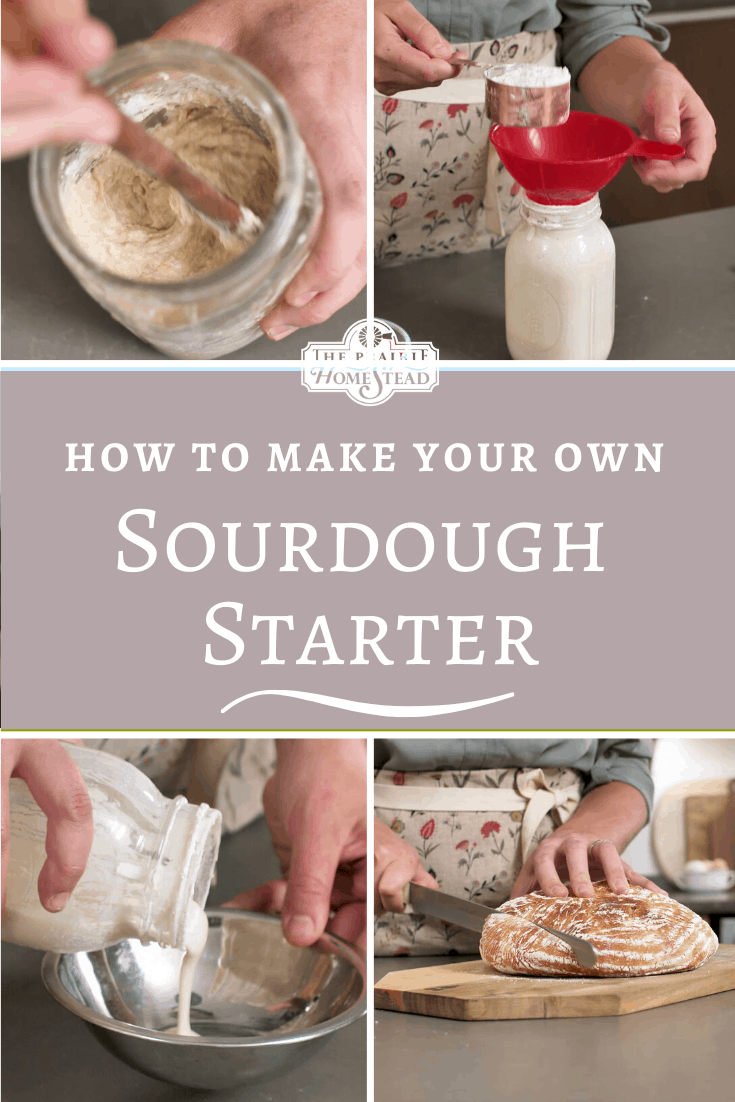
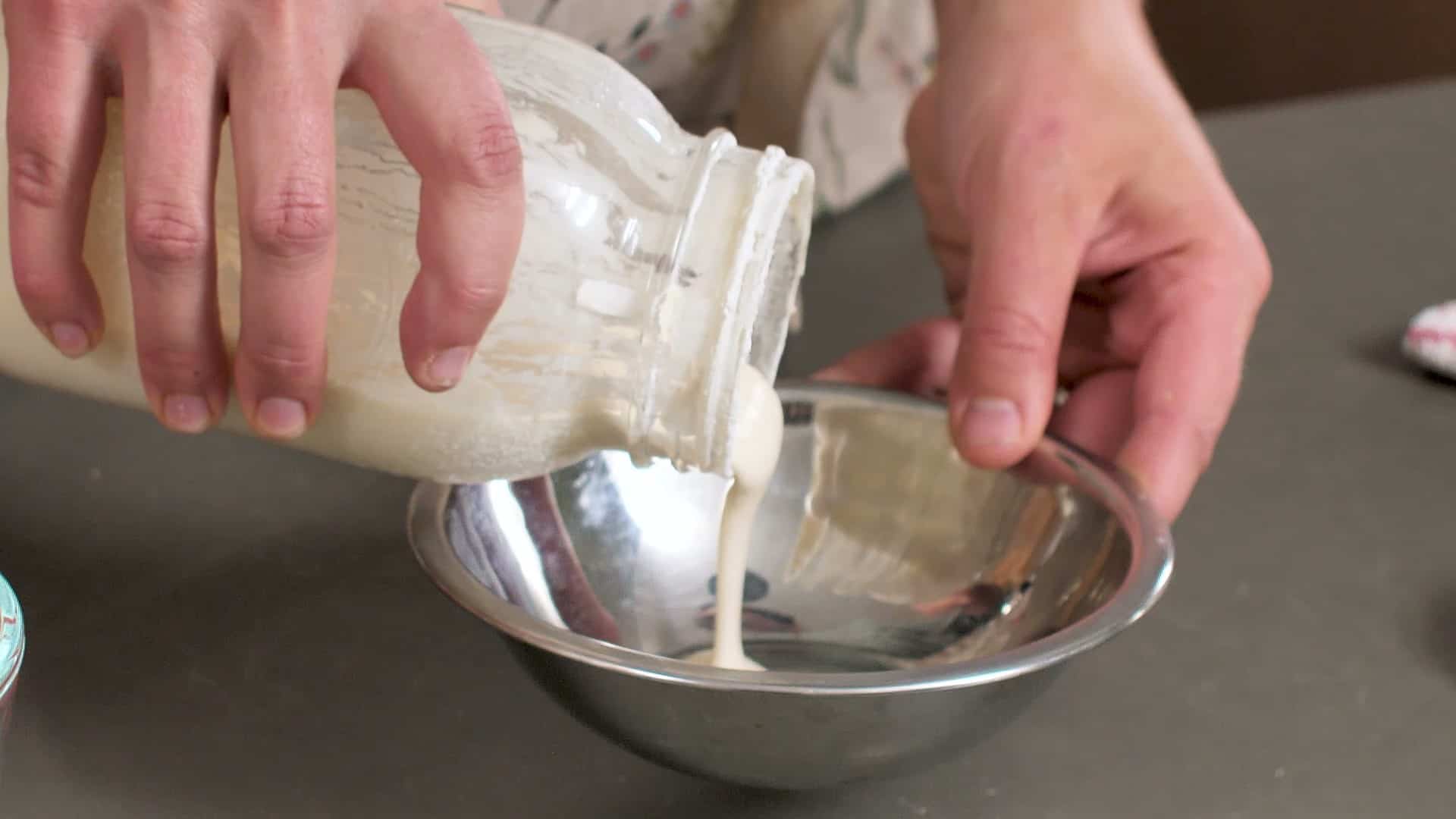

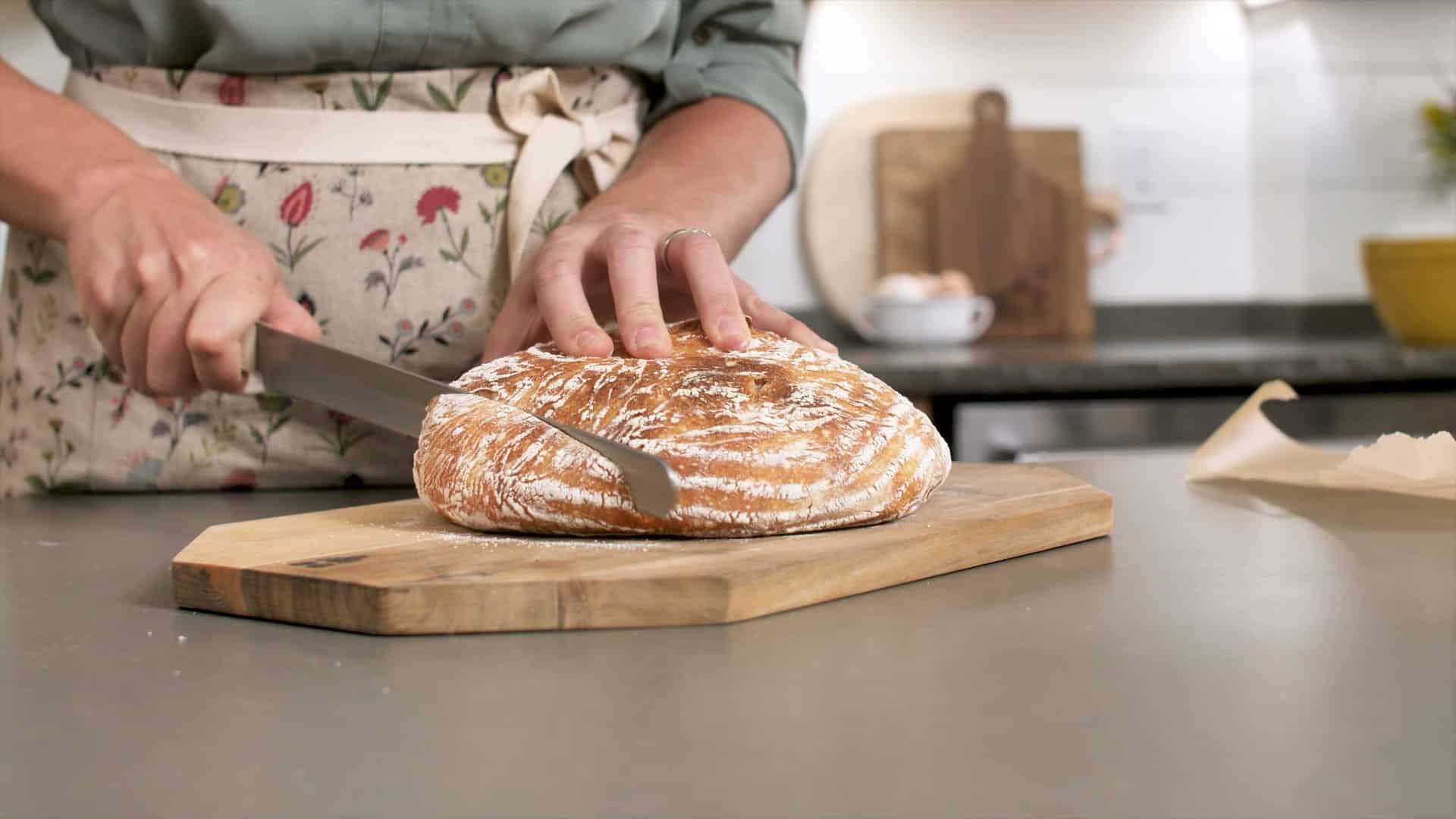


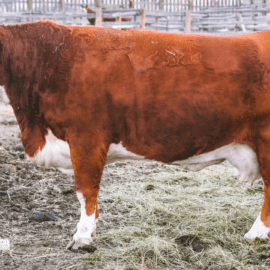
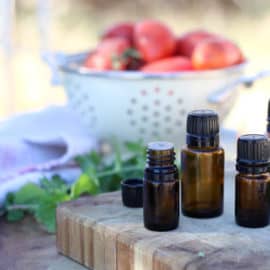
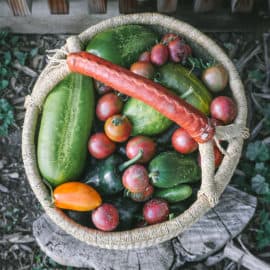
Hi! I’ve been baking breads as a hobby just this year, & i enjoy doing it. I’m from the philippines, & wondering if our tropical climate affects my breads. I’ve been using mostly your recipes coz they’re great for us beginners, & have met with at least 85% success. My wife n’ kids just started to appreciate good bread when i started baking. Normally, we eat rice. Just wanted to extend my appreciation to you. Thanks a lot!
I just found this and got so excited to start this. Off I went and things started slow (I had to wait 48 hrs to see movement). So happy with day 2 progress, I went to bed and my starter had easily doubled in size. I went to bed and came to look the next morning and bam back down to where I started. All the growth was gone. So I waited until my house warmed up and still no progress. So I decided to feed it in hopes that it would bounce back. Sadly it has not budged. Did I do something wrong should I leave it be and wait another day before I feed it again? I started this on 4/18, fed it 4/20 and 4/21. No movement since 4/20 around 9 pm. Help????
Keep going. I watched another tutorial on starter and his did the same thing. It bounced back just fine!
On day 4 and no rising but I do have bubbles. The first rise gave me false hope that I was doing it correctly. Now I am feeding it 1:1:1 ratio 2x a day (12 hrs apart). How long should I keep this up if I’m not getting any more rising?
No! You didn’t do anything wrong! Just keep feeding it! The nature of sourdough is that it rises and falls!
Hi Kayal!
I am on day 5 and have fed it according to the directions here. I have a lot of bubbles everyday and it smells on the stronger side a bit unpleasant but it is not doubling in size, it is not really growing at all. Should I wait and continue a few more days or start over completely fresh? Thank you SO much! 🙂
I had the same experience, but kept going with it and put it in my kitchen window to warm. Day 8 and it’s perfect.
I was wondering around what temperature starter need?
Your starter will adapt to whatever temperature your house is at. Keep in mind that the warmer the temps, the faster your starter will ferment, and the colder the temps, the longer your starter will need to ferment/double.
I’ve made the starter from your cookbook. It says to use 1/2 cup flour and 1/4 cup water. It just makes a ball of dough. Is this normal?
Took me six weeks. One night it quadrupled and was good after that. Don’t give up.
Oh the hope you just gave me!! THANKS
Can you give us a recipe or two for using the starter?
Oops, I found them. Sorry about that.
Where did you find them?
Look through the whole post.
Can I use bread flour in replace for the AP flour?
My sour dough starter is on day 4. I notice it seems to clearly separate with a cloudy, watery layer, in between two puffy and bubbly layers. When I deflate and mix it, the starter seems almost pressurized. Is this good/normal?
Hard to tell but from the sounds of it, it seems like your starter might like more food (isn’t being fed enough). Liquid in starter like that (called hooch) usually forms because it’s hungry. Try feeding it more then you have been, and see if that doesn’t work for you.
Our recipe from back in the 70s and 80s was 2 c s.-r. flour, 1 c sourdough,
1/2 stick butter (oleo) melted and about luke warm, 1/4 c warm water mixed with 1 pkg
of yeast. Keep dough soft. Bake at 350. We would let ours rise up to 2-3 times before we made rolls, etc. We had to let it die because we were eating too much of it.
Hi there. So I’ve got my sourdough starter going, now just wondering how to make the bread. Help please:) thank you
Did you find any recipes?
Today I’m going to be THAT guy and ask a totally unrelated question. We’ve recently discovered your podcast. I enjoy but more importantly it is he first podcast my wife will listen to on her own. So, THANK YOU! Hopefully it will be the gateway podcast but if not, at least it is one…
Anyway, episode 35, essential oils. Can we use a drop of Dill essential oil when water bath canning pickles?
Thanks and love the book, Mark
Not the author, but you don’t want to eat essential oils! They’re not just herb oil, they’re harmful for you.
I just found your website so haven’t tried the recipe yet. I wanted to reply to Mark about using essential oils in recipes. I would only use a Certified Therapeutic Grade oil such as doTerra. And doTerra does make clear those oils that are suitable for ingesting. I haven’t tried full, but I do regularly ingest lemon and peppermint. An extra drop or two of full would probably be fantastic! Best!
I tried to post on the apple cider blog but it is closed. Your recipe for apple. Idee sounds nice but if it works it’s only because of luck. It just makes rotten apple scraps. I actually tried it three times to see if it would work. My background as a physician with a masters degree in biochemistry gives me license to comment. You are correct in that you first have to make hard apple cider but in order to do that you have to add a high-quality yeast to an otherwise sterile environment. Your technique depends on one of the billions of contaminated bacteria and yeast present in your unsterile concoction being the right one and outgrowing all the others. Read about how to make hard apple cider and you’ll see what I mean. After you’ve made hard apple cider you then need to add the mother which is an acetobacter colony and slime which will convert the alcohol to vinegar. Besides you can’t replace apple cider with apple scraps and sugar. I cannot stand these websites which are basically Clickbait for advertisement that promote faulty information.
I have been trying to find what I do after the starter is ready and there is nothing. How do I actually make it into a loaf? There are no instructions anywhere! Help
King Arthur Flour is a great resource for the moment. They have lots of recipes to help you get started.
I began a starter the other day with whole wheat flour. It was bubbly and foamy 24 hours later but it also had a small spot of what looked like green mold. What happened? I’m guessing not enough air circulation 🙁
How long can i leave the starter in the fridge without using it? And do i have to feed it in fridge if its not use?
Thanks
You can leave your starter in the fridge for quite a while and have it bounce back. If your starter is in the fridge, and you want to use it for baking, you should try to feed it once a week to keep it active.
Do I start with a 1/4 cup of water of 1/2 cup of water and 1/2 cup wheatflour? The text says both. The cookbook says 1/4 but isn’t that too dry? I looks like a brick.
Greetings from the Netherlands,
If you mix up your starter and it looks too dry, you can always add some more water. I aim to get my starter about the consistency of a muffin or pancake batter.
I LOVE this whole crew and the real home feel it is! None of that pretentious, dress it up and make it perfect – but real is where it’s at! Bring on the sourdough bread days again! I’m fifty seven years old and had this for years making bread for my family of seven, every other day, in five gallon buckets – what a blast we had. Gonna start another starter now for the people I work with and my grandkids fun! Thank you!
Right on! Gotta love authenticity, especially in these times where it’s not always easy to find on social media. So happy to hear that you’re gonna make a sourdough starter with your grandkids! How fun.
I think the problem is that Day 1 of the printed version of the recipe says to use 1/4 cup of water, but the instructions above say 1/2 cup. 1/4 cup on the first day is WAY too dry… I ended up using 1/2 cup for Day 1 and 1/4 for Day 2 and beyond.
I’m on day 9 of my starter, which is 3 days of letting it sit and 6 days of feeding. I did not discard any until day 4 of feeding (forgot that step.) My starter has some bubbles but no rising. Good news is it smells sour and good. Maybe a little floury. I think I may be keeping it too thick(?) It’s too thick to pour. Can I revive it at this point? Another thing: 125 gm flour is about 1/2 cup by weight. 125 gm water is about 1/4 cup by weight. So are feedings supposed to be 1:1 volume, as a lot of recipes say, or weight:weight as a lot of recipes say? Two VERY different consistencies. Thanks.
I would recommend discarding some of your starter so that you can make sure you’re feeding your starter enough. It sounds like your starter may not be eating enough to be/stay active, but it also might simply need more time to become active and established. I would just keep feeding and discarding for a few more days and see what happens. If you’re discarding, there are other things you can make with the discard so you don’t have to throw it out–such as brownies, crackers, and such.
Your printed instructions show 1/2 C flour to 1/4 C water. The ratio above the print out is 1:1, this seems right. The 2:1 is too dry
Hello! I just came across your site. I was interested in trying the easy sandwich bread recipe (above) with the sourdough starter instead of the dry yeast. It says above, to use more yeast and shorter rise times. I looked through the recipe for the sandwich bread looking for guidance on quantities to use because I’m a total newb but I didn’t see anything. I totally could have missed it too ? Can you please advise on how much sourdough starter to use and times for rising. TIA!
Hello, I looked through the site as well as comments and I couldn’t find any guidance on how much sourdough starter and shorter rise time is needed if I make the easy sandwich bread recipe with sourdough starter instead of dry yeast. “If I’m in the mood for a light, fluffy loaf, I’ll make an easy sandwich bread recipe with more yeast and a shorter rise time.” TIA
I’ve got my first starter on day 2 right now and it’s doubled in size. How do I replace starter for yeast in a recipe? I have no idea how much to use. Thanks!
Jill actually shared her favorite beginner sourdough bread recipe here: https://www.theprairiehomestead.com/2020/04/sourdough-bread-recipe.html
Hi…my starter is bubbly and rising too…but it is seventh day today and it has not doubled yet. It is also very sour..,what do i do to chek if it is ready to use in bread making? Please reply…thanks.
I have tried making this stater twice, using your exact recipe, loosely covered on my kitchen counter, in South East TN. Each time, I start to get pink streaks by day 3 (bacterial growth I presume, although it is nice and bubbly underneath and smells fruity and yeasty). What am I doing wrong? Can you recommend anything else that I can try?
I just read today in a bread group, that pink streak is mold. You probably need to start over. Sorry.
Oh no! Sorry to hear that! Perhaps you could try discarding/feeding the starter 2x/day versus just once (step three) until it becomes established. Hopefully that will help you not get the pink streaks.
Hello!
When you repeat step 3, do you take out half of the starter every time? I am on day 4 wondering if I take some out again. Thank you!
Yup!
Hi,
My sourdough starter stopped! I ran out of flour so I pulled some out of the freezer. I started another one but so far no bubbles. It has only been less than two days on the new one but does flour that has been frozen cause a problem?
Thanks,
Wendi
Hey Wendi! I can’t imagine why frozen flour wouldn’t work… I’d just give it more time, and hopefully it’ll spring back to life. 🙂
Sweet! Thank you!
Hi! Love this post and your post for an easy sourdough loaf! I’ve got my starter active, have set some aside to start a loaf tonight (???) and I have the rest in a sealed mason jar in the fridge. My question is, when it comes time to feed my dormant starter (if I don’t plan to bake) do I need to let it come to room temperature before I feed it? And then how soon after feeding it can I put it back in the fridge? Thanks so much!
Hi, I was wondering if I can use whole wheat flour for the starter and feedings or is it a must to use white flour? If it makes any difference I have soft and hard white wheat flours and hard red flour. Thank you for your help! I’m so excited to try my hand at sourdough!
Sourdough can be fed any form of grain, so you should be good to go with whatever option you choose to feed your starter.
Thank you!
Started my first ever sourdough starter 6 days ago. Started out great, the first day I had bubbles, and after feeding it it almost doubled in size by the 3rd day. After day 3 I discarded some and fed it again and ever sense this step I’m not getting it to double in size, it’s very bubbly and I get a liquid that builds up on the bottom, I have continued to stir it discard and feed Each day. I’m at a loss of what to do to fix it? 2 of the days it smelt horrible (vomit like). Any tips would be greatly appreciated!
The liquid forming on top of your starter is called hooch. It’s just alcohol that the yeast in your starter produces when it’s hungry. Sounds like you just need to feed your starter a bit more, and maybe a bit thicker to help it double in size. You can either stir the hooch back into the starter or pour it off, either way is fine.
Wow this is great!!! I have wanted to try sourdough for so long and now I am not scared to! I found this recipe for sourdough ”discard”. https://www.epicurious.com/recipes/food/views/sourdough-biscuits Thank you!!!
SO glad to hear this! 🙂
I’m wondering if you know this answer or can guide me. My daughter has celiac disease. So we have only ever bought store bought gluten free bread. I’ve been finding information that she could possibly tolerate sourdough starter made bread. Your thoughts.
Without any personal experience on the matter, I have heard the same thing. Given the nature of sourdough,and how the dough is long fermented, it is easier for your body to digest, even sometimes for people who have a hard time digesting gluten. Don’t know too much about it, and it’s a personal choice if you want to try it out and see if your daughter can safely have sourdough. Again, I’m not an expert on this topic.
Hi! Thank you for posting this.
I have two questions:
1. My hubby is sensitive to commercially made breads (wheat belly). Will this be better for him? He is having a hard time with the thought of giving bread up entirely.
2. What size canning jars are you using in the video?
Thanks for reading. 🙂
Given that sourdough bread is actually long-fermented, it’s actually easier for our bodies to digest. I couldn’t tell you for sure if your husband will be less sensitive to sourdough bread, but I would give it a shot! It’s never fun to feel yucky from food. Secondly, in the video Jill uses both a wide mouth quart and a half gallon jar for her starter.
I recently found you and this recipe. My starter has been going great. Do I really need to wait 3 weeks before I make bread?
I’ve made pancakes and waffles from the discard (YUMMY!!)
I am feeding my starter a 1:1:1 ratio…it is not rising until about 6-8 hours after I feed. I have been doing this for weeks and I don’t want to give up. It was doing great when i was feeding it whole wheat flour, but sadly I have run out, I have been using all purpose instead. Do you think the change in flour could be why its so sluggish? Any inside would be greatly appreciated.
Hello,
Thank you so much for the recipe! But I have a question. I have whole wheat flour on hand that I will use to start the starter. Can I also use whole wheat flour when feeding the starter on days 2, 3, 4… instead of all purpose flour? Will the water ratio still be the same?
Yes! You can totally continue feeding whole wheat flour after your starter is active! The water ratio should be similar, but whole wheat flour does seem to soak up water more than all-purpose, so keep that in mind, and you may need to adjust the ratio just a bit.
I can’t find any whole wheat flour on the shelves these days but I do have whole wheat bread flour. Could I use this and would the water to flour ratio be the same as listed in the cookbook?
You can definitely use that. The ratio should be the same, but still use your best judgement. If the starter seems to dry, add a bit more water, and vice versa. I like to keep my starter about the consistency of a thick pancake or muffin batter.
I’m slightly confused by the clarification. I’m going onto day 4 and do I discard half every day and feed it? Then in 4-6 hours if it hasn’t doubled feed it again for 7-10 days?
can i add olives to make sourdough olive bread ? if so, when to add the olives??
I just found your website and am wanting to learn how to make sourdough bread. Can gluten free flour be used for the flours?
what do you mean you throw 1/2 away ,is this mean you use it. Trying to make sour dough starter Thanks
I like sourdough bread but I want to make a starter for white bread. I google starter from scratch and all I see is for sourdough. What can I do to not make sourdough starter.
Thank you
Audrey cushman
Sourdough starter is also natural leavening. It doesn’t make a sour flavored sourdough loaf unless you leave the bread dough processing for a long enough period of time to develop the sour flavor (usually over 12-24 hours). If you have a happy bubbly starter that doubles in 3-4 hours, you can use it to leaven your white bread loaf just fine. Just let the dough sit 5 or six hours, shape it into loaves, let it sit 2 more hours and bake it. If you feel like it has a sour flavor, and you don’t care about it processing the full amount of time for health benefits, you CAN just let it sit an hour, shape it into loaves, and cook it whenever it doubles. That’s at summertime temperatures. Winter might take longer if your house is cold. Usually, in the winter, 12 hours won’t even make it sour. I’ve also heard that water temperature can affect how sour flavored your loaf ends up…
A while back I made glue from some plain white flour and a splash of water. I left it on the counter for two days while I was using it and then one morning I found it bubbling! Part of me wanted to see what’d happen if I tried feeding it, but my brush had been in there, so probably not too healthy haha.
i started the starer, day two the flour and water mixture had at least tripled. it over flowed a pint jar.
I am continuing to feed it,
Is this normal and is it OK to continue.
Hi. Heads up! I started my starter, it was working perfectly, but on the 3rd day I forgot and used straight tap water. Had to start over.
I’m on day 8 with my starter and today I accidentally fed it without discarding half of it first. Will it be ok or do I need to start over ? It was doing so well!
I live in the Boulder Mountains in Montana. I just got back into bread making after many, many years. I just discovered crock pot bread as well as dutch oven (which I just purchased). My hubby has been bugging me for sourdough bread. I have never tried making it, so of course I went to my homesteading source, Jill! Thank you so much for taking me through the process effortlessly! I just made my first sourdough bread, & it was a great success! We both were so pleased with how it turned out. I will keep feeding the starter… can’t wait to make english muffins.
Well I hate asking as I know it will no doubt bring more than a few whole hearted belly laughs to some, but here we go:
After you make the starter… how do you actually MAKE the bread with it?
Is there a common recipe everyone uses or is there one specifically for this starter?
Hi, I am following the recipie, am on day 6. My sourdough starter is at least doubling in size, has so many beatiful different sized bubbles,smells amazing, is foamy…. BUT It is not passing the float test and is thick and really sticky,
Question! I have a starter on day 11 that’s just about ready to use – started with whole wheat for the initial mix then switched to all-purpose but my starter was super hungry and not doing much by day 8 or so. I switched back to whole wheat for the feeds and it’s doing great but is thick and not runny, is that ok or should I increase the water in my 1:1:1 ratio?
I can’t wait to try this. I’ve left my county water on the counter uncovered overnight & I’ll be making the starter shortly. My question is, I was hoping to use whole wheat flour for the feedings also instead of using all purpose flour. Started the Mediterranean “lifestyle” about a month ago & really wanting to stick with whole grains for everything. Would this recipe still work nicely if fed whole wheat flour in place of the all purpose?
Yes, whole wheat flour should work just fine!
Hey! Love your recipes by the way. I have a quick question about the starter. I have my sourdough starter in a half gallon mason jar. Do I still have to discard half of it and add more? Or can I just keep adding to it? Thank you.
You can just keep feeding it if you want that much starter! Just make sure you’re feeding it enough to keep it healthy and active.
Thank you, this is the very best explanation I’ve read, in beginning a starter, and I have read a lot of starter recipes, which had led to some starter failures. Your starter recipe is so easy to follow, I can’t fail this time. Thank you, and I will be following the PRAIRIE HOMESTEAD site from now on.
I am wondering if it’s possible to make sourdough starter using all freshly ground wheat flour? Don’t want to use any all purpose flour at all?
Of course! Just keep in mind that because whole grain flour absorbs more water than all purpose flour, you might have to adjust the texture with additional water if it’s too thick. Learn more about the baking tips and tricks with freshly ground flour here: https://www.theprairiehomestead.com/2020/06/make-own-flour.html
Jill,
When you say whole wheat flour for this recipe, are you referring to commercial whole wheat flour, or fresh ground whole wheat flour from wheat berries?
I’ve been maintaining a sourdough starter since summer of 2020. Only using all purpose flour and water. I’ve recently just tried making bread and a discard recipe for pancakes.
But I am starting to feel a little adventurous, especially after your recent podcast episode about heritage grains.
What recipe would you use for a sourdough starter using freshly ground whole wheat?
Hi there! I am completely new to sourdough. I tried this recipe, and it was going great, but then my starter got a terrible smell on day three! It smelled rancid? Is that how sourdough is supposed to smell? Thanks for any help!
A sourdough starter shouldn’t smell rancid. A fermented tangy smell is okay but rancid probably means something went wrong and you might want to try again. Check out this post for some tips on what might have gone wrong: https://www.theprairiehomestead.com/2020/04/sourdough-troubleshooting.html
So I finally made my first starter two nights ago. After 24 hours there weren’t bubbles. Then about 12 hours later tons of bubbles and I went to add to it and there was mold! Not a lot but still.
We are in England overseas and have trouble with our home temperature so it did go between warm and cold and warm again a few times.
Maybe a more regular heat or leave it on the cooler counter?
Temperatures affect the quickness of your starter becoming lively, but doesn’t usually connect to mold. Mold issues are usually connected with contaminated things. Perhaps your jar wasn’t cleaned properly, or your flour went bad, or your water source was not good. That’s usually what causes mold for your sourdough starter. Are you sure it wasn’t the “hooch”? You might want to google that to see what it looks like for sourdough. You might also want to look over the troubleshooting tips for starters in this post: https://www.theprairiehomestead.com/2020/04/sourdough-troubleshooting.html We hope you have better success the second time around!
Hello! I’m planning to make this starter today and was wondering for the whole wheat flour in the beginning if it’s okay to use all-purpose Einkorn flour, as I don’t have regular whole wheat flour available at home. Thank you!
Yes, you can use other flours for your starter, however, you will need to research how to tweak the ratios, since different flours need different amounts of liquid/etc. Check out Jill’s article here to learn a bit more about einkorn flour: https://www.theprairiehomestead.com/2021/12/how-to-use-einkorn-flour.html
Hi Jill
I just wanna ask you if l can bake a sourdough bread on the stove? I don’t have an oven.
Thank you
Nicole
As far as I know, the heat from the stove top is not going to be strong enough to bake bread. You could try to research bread recipes that can work on an outdoor fire. There might be some recipes for that. Best of luck in your search!
Can I make a starter without using all purpose flour? I generally use fresh ground flour from Kamut grain. We currently do not use all purpose flour in our kitchen at all. Thanks for advice!
I started the sourdough starter process 5 days ago (Saturday), and I was already seeing bubbles a d the starter doubling on Monday and Tuesday, which was exciting! I then decided to transfer it to a bowl because I didn’t like the jar I was using, it was narrow. Since transferring the starter doesn’t seem to be doubling and isn’t as bubbly. Should I start over, or give it a few more days? Is there something special about using a jar?
It can take up to three weeks for a starter to be consistently active. I’d suggest waiting and see if it recovers and keep feeding it.
Ok, thanks. I thought it was odd that I initially saw bubbles and it doubling and once I transferred it to a bowl that slowed down. Is that unusual? Also, should I keep using all-purpose flour or should I use some more whole wheat?
You can feed it either all purpose or whole wheat. Or a mix. It will be great with all of those options.